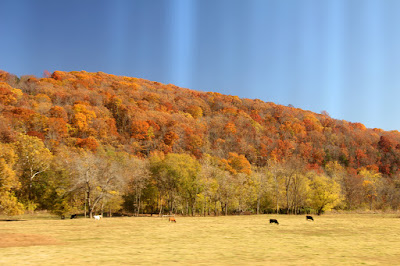Much of the history in the beautiful countryside is being preserved.
The bridge in the background, that no longer meets modern specs,
is being moved intact to where it can be used rather than being
torn down.
Our return trip was in car 107 with its beautiful patterned tin
ceiling, called a Wunderlich ceiling.
The 139.5 mile-long line was built
between 1880 and 1882 by the St. Louis and San Francisco Railroad, a
predecessor of the Burlington Northern.
On the trip out and back, we used two different coaches. Car 105 was built in 1927 in Wilmington,
Delaware, and Car 107 was started in 1955 and completed the following year. The Victorian coaches are fully restored in
the greatest detail with mahogany interiors, plush velvet upholstery, and pressed
tin ceilings called Wunderlich ceilings named for the Austrian manufacturer. The rails twisted and turned through the
mountains. We crossed three trestles
that carried the train across the creeks and gave miles of visibility. Two were about 110-feet above the creeks,
and one, the Winslow trestle, is 125-feet high.
This makes it 1,735 feet above sea level and the highest railroad
trestle between the Appalachian Mountains and the Rockies. This leads the train into the 1,702 foot-long
Winslow Tunnel. With all the twists
through mountain passes, across and along numerous creeks, and over elevated
trestles, it would have been a train modeler’s fantasy dream.

In my youth, these double-decker 1940's-era Zephyr Vista Dome
cars were the epitome of first-class travel. I had always wanted to
see one, but it wasn't until this trip that I climbed on one with the
cleaning crew hard at work. Fortunately, I found this picture on
the Arkansas & Missouri web site sans cleaning crew and vacuum
cleaners.
This picture blurred as I tried to take it from the train as we flew past,
but it was important enough I felt it should be seen anyhow. The
construction on the Winslow Tunnel began on Sept. 26, 1881 with
a 300-man crew. Conditions were severe, and once inside the tunnel,
the air was scarce and stale. Men's skin turned yellow as they
grew weaker. Then smallpox swept through the crew with many
deaths, some buried in nearby cemeteries, some buried right along
the tracks they were laying. With the warming of spring, malaria
was added to their health challenges. The work had to be completed,
but the railroad president felt so bad about the toll in human life
(a condition I doubt we'd see in American industrial life today),
that he stipulated in his will that his body be returned to lay with
his workers on the mountain, and here he lies between two of
his employees.
Winslow was a small, isolated
mountain town until the Winslow Tunnel broke though the mountain and made it a
picturesque town that was popular with people from Van Buren and Fort Smith
wanting to escape the summer heat by retreating to the mountains. Winslow became the movie set for two
movies. “Frank and Jesse,” was a 1995
film about the James brothers, and starred Rob Lowe, Bill Paxton, and Randy
Travis. A 1975 film, “Smoke in the
Wind”, was about a southern family’s struggles following the Civil War. It was Walter Brennan’s last film. He passed away in September, 1974, before the
film was released the following year.
Greater Downtown Winslow. There is one more red building
to the left of these.
Arkansas & Missouri Railroad still runs passenger service from
this depot.
The perfect Ron Howard-styled movie set.
The Talimena National Scenic Byway is
a beautiful 54-mile drive through the Kiamichi Mountains and the Quachita
National Forest. We had wanted to make
this trip for some time, so decided to tack it onto the train trip. Dropping south on Rt. 71 from Fort Smith, we
started at the east end of the byway in Mena, Arkansas. Right in the heart of town by the train
station, Mena Street turns north off of Rt. 71 and becomes Rt. 88 or Grandview
Heights. It was a fun, twisting ride
through the mountain tops with magnificent vistas and interesting places to
stop. At the Oklahoma/Arkansas state line, Rt. 88
becomes Rt. 1 and continues to its terminus at Talihina, OK.
Sunset on the Talimena Trail.
































